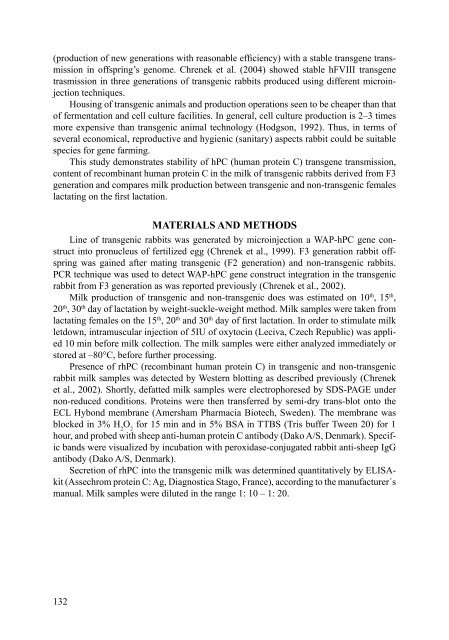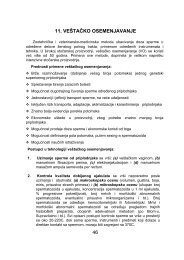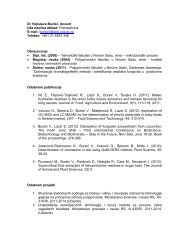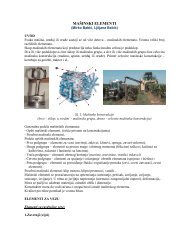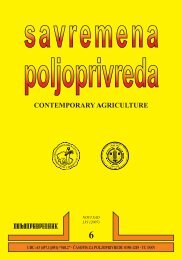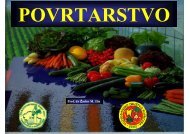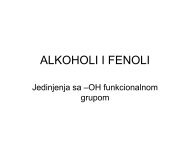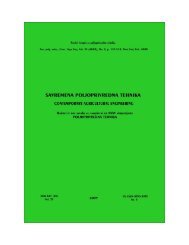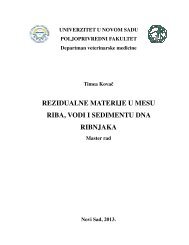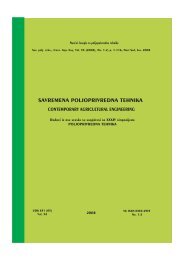2008 Savremena poljoprivreda 57 1-2.indd - Poljoprivredni fakultet ...
2008 Savremena poljoprivreda 57 1-2.indd - Poljoprivredni fakultet ...
2008 Savremena poljoprivreda 57 1-2.indd - Poljoprivredni fakultet ...
You also want an ePaper? Increase the reach of your titles
YUMPU automatically turns print PDFs into web optimized ePapers that Google loves.
(production of new generations with reasonable effi ciency) with a stable transgene transmission<br />
in offspring’s genome. Chrenek et al. (2004) showed stable hFVIII transgene<br />
trasmission in three generations of transgenic rabbits produced using different microinjection<br />
techniques.<br />
Housing of transgenic animals and production operations seen to be cheaper than that<br />
of fermentation and cell culture facilities. In general, cell culture production is 2–3 times<br />
more expensive than transgenic animal technology (Hodgson, 1992). Thus, in terms of<br />
several economical, reproductive and hygienic (sanitary) aspects rabbit could be suitable<br />
species for gene farming.<br />
This study demonstrates stability of hPC (human protein C) transgene transmission,<br />
content of recombinant human protein C in the milk of transgenic rabbits derived from F3<br />
generation and compares milk production between transgenic and non-transgenic females<br />
lactating on the fi rst lactation.<br />
MATERIALS AND METHODS<br />
Line of transgenic rabbits was generated by microinjection a WAP-hPC gene construct<br />
into pronucleus of fertilized egg (Chrenek et al., 1999). F3 generation rabbit offspring<br />
was gained after mating transgenic (F2 generation) and non-transgenic rabbits.<br />
PCR technique was used to detect WAP-hPC gene construct integration in the transgenic<br />
rabbit from F3 generation as was reported previously (Chrenek et al., 2002).<br />
Milk production of transgenic and non-transgenic does was estimated on 10th , 15th ,<br />
20th , 30th day of lactation by weight-suckle-weight method. Milk samples were taken from<br />
lactating females on the 15th , 20th and 30th day of fi rst lactation. In order to stimulate milk<br />
letdown, intramuscular injection of 5IU of oxytocin (Leciva, Czech Republic) was applied<br />
10 min before milk collection. The milk samples were either analyzed immediately or<br />
stored at –80°C, before further processing.<br />
Presence of rhPC (recombinant human protein C) in transgenic and non-transgenic<br />
rabbit milk samples was detected by Western blotting as described previously (Chrenek<br />
et al., 2002). Shortly, defatted milk samples were electrophoresed by SDS-PAGE under<br />
non-reduced conditions. Proteins were then transferred by semi-dry trans-blot onto the<br />
ECL Hybond membrane (Amersham Pharmacia Biotech, Sweden). The membrane was<br />
blocked in 3% H O for 15 min and in 5% BSA in TTBS (Tris buffer Tween 20) for 1<br />
2 2<br />
hour, and probed with sheep anti-human protein C antibody (Dako A/S, Denmark). Specific<br />
bands were visualized by incubation with peroxidase-conjugated rabbit anti-sheep IgG<br />
antibody (Dako A/S, Denmark).<br />
Secretion of rhPC into the transgenic milk was determined quantitatively by ELISAkit<br />
(Assechrom protein C: Ag, Diagnostica Stago, France), according to the manufacturer´s<br />
manual. Milk samples were diluted in the range 1: 10 – 1: 20.<br />
132


